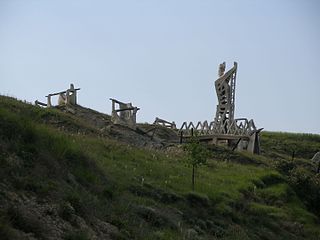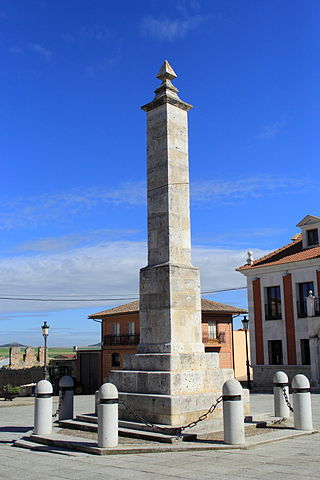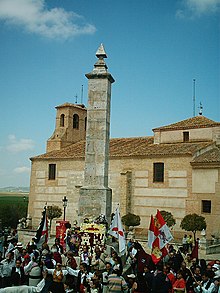
Juan López de Padilla was an insurrectionary leader in the Castilian War of the Communities, where the people of Castile made a stand against policies of the Holy Roman Emperor Charles V and his Flemish ministers.

The Revolt of the Comuneros was an uprising by citizens of Castile against the rule of Charles I and his administration between 1520 and 1521. At its height, the rebels controlled the heart of Castile, ruling the cities of Valladolid, Tordesillas, and Toledo.

María Pacheco was a leader in the Revolt of the Comuneros in Spain, an uprising of the citizens against the monarchy.

The Castilian Left is a leftist nationalist political movement active in the Spanish autonomous communities of Castile-La Mancha, Castile and Leon and Community of Madrid. It strives to advocate for the national recognition of Castile, and in some cases, its independence. Other current political parties include Tierra Comunera, Castilian Party, and Ahora Castilla.

The Battle of Noáin or the Battle of Esquiroz, fought on 30 June 1521 was the only open field battle in the Spanish conquest of Iberian Navarre. It was a decisive victory for the Spanish against the Franco-Navarrese army.

Villalar de los Comuneros is a municipality located in the province of Valladolid, Castile and León, Spain. According to the 2004 census (INE), the municipality had a population of 449 inhabitants.

The Revolt of the Brotherhoods was a revolt by artisan guilds (Germanies) against the government of King Charles V in the Kingdom of Valencia, part of the Crown of Aragon. It took place from 1519–1523, with most of the fighting occurring during 1521. The Valencian revolt inspired a related revolt in the island of Majorca, also part of Aragon, which lasted from 1521–1523.

Juan Bravo de Lagunas y Mendoza was a leader of the rebel Comuneros in the Castilian Revolt of the Comuneros.

The Army of the North, contemporaneously called Army of Peru, was one of the armies deployed by the United Provinces of the Río de la Plata in the Spanish American wars of independence. Its objective was freeing the Argentine Northwest and the Upper Peru from the royalist troops of the Spanish Empire. It was headed by Hipólito Vieytes (1810), Juan José Castelli (1810–1811), Juan Martín de Pueyrredón (1811–1812), Manuel Belgrano (1812–1814), José de San Martín (1814), José Rondeau (1814–1816), Manuel Belgrano (1816–1819) and Francisco Fernández de la Cruz (1819–1820).

Cardinal Guillaume, Guillermo or William de Croÿ, a member of the noble House of Croÿ, was Prince-Bishop of Cambrai from 1516 to 1519 and Archbishop of Toledo from 1517 to 1521. He was born in the Habsburg Netherlands and died in Worms, Germany.

Castile and León Day is a holiday celebrated on 23 April in the autonomous community of Castile and León, a subdivision of Spain. The date is the anniversary of the Battle of Villalar, in which Castilian rebels called Comuneros were dealt a crushing defeat by the royalist forces of King Charles I in the Revolt of the Comuneros on 23 April 1521.

The Spanish conquest of the Iberian part of Navarre was initiated by Ferdinand II of Aragon and completed by his grandson and successor Charles V in a series of military campaigns lasting from 1512 to 1524. Ferdinand was both the king of Aragon and regent of Castile in 1512. When Pope Julius II declared a Holy League against France in late 1511, Navarre attempted to remain neutral. Ferdinand used this as an excuse to attack Navarre, conquering it while its potential protector, France, was beset by England, Venice, and Ferdinand's own Italian armies.
Military conflict in the Revolt of the Comuneros spanned from 1520 to 1521. The Revolt began with mobs of urban workers attacking government officials, grew to low-level combat between small militias, and eventually saw massed armies fighting battles and sieges. The comunero rebels gained control of most of central Castile quite quickly, and the royal army was in shambles by September 1520. However, the comuneros alienated much of the landed nobility, and the nobility's personal armies helped bolster the royalist forces. The Battle of Tordesillas in December 1520 would prove a major setback for the rebels, and the most important army of the comuneros was destroyed at the Battle of Villalar in April 1521.
Íñigo Fernández de Velasco, 2nd Duke of Frías, Grandee of Spain, and Constable of Castile, was a Spanish nobleman.
Antonio de Zúñiga y Guzman,(c.1458 – 1533), Prior of Castile, Order of Saint John of Jerusalem, Plasencia, Spain, was the general of the Royal Army against the Revolt of the Comuneros and a Viceroy of Catalonia from 1523 - 1525.

Pedro Téllez-Girón y Fernández de Velasco or Pedro Girón, was a Spanish noble, 3rd Count of Ureña and a leader of the Revolt of the Comuneros.

The Execution of the Comuneros of Castile is a history painting by Antonio Gisbert, from 1860.

The Battle of Tordesillas was an armed conflict fought during the Revolt of the Comuneros, that engaged the royalist forces commanded by the Count of Haro and the comuneros garrison of the Valladolid town of Tordesillas, the headquarters of the rebels, on December 5, 1520.















